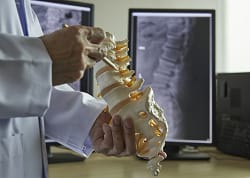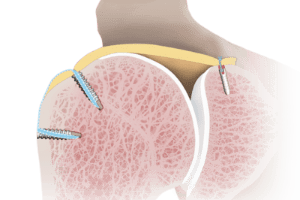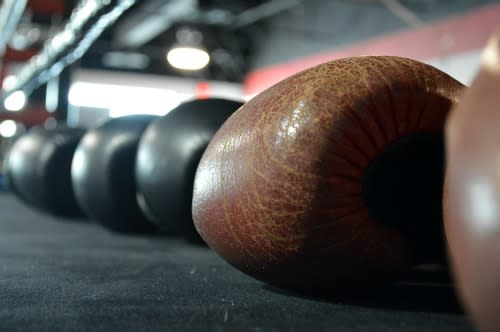The meniscus is a crescent-shaped band of cartilaginous tissue that serves as a shock absorber between the thigh bone and the knee bone. Divided into the lateral and medial menisci, the tissue provides structural integrity to the knee when it is subject to weight bearing and flexion/rotation.
A torn meniscus is one of the most common knee injuries endured by orthopedic patients. Any activity that causes a forceful twist, pivot or rotation of the knee, especially while putting pressure or weight on the joint, can lead to a torn meniscus. Athletes who play sports such as soccer, football, tennis and basketball are at greater risk of injury. In older adults, degenerative changes and general wear and tear due to age may cause a torn meniscus, which can occur while kneeling, squatting or lifting something heavy.
A popping sound or sensation is often associated with a torn meniscus. Other common signs and symptoms include: swelling or stiffness, pain while twisting or rotating the knee, difficulty straightening the knee fully or experiencing what feels like a block to movement of the knee – as if it was locked in place. Experiencing one or a combination of these should prompt a visit to the doctor.
A torn meniscus can often be identified during a physical exam, as a doctor will manipulate the knee into different positions to pinpoint the cause of symptoms. An MRI is usually ordered to confirm the diagnosis. The course of treatment following diagnosis depends on the needs and status of the patient. Occasionally, conservative treatment including rest, flexibility and strengthening exercises, ice and medication can be enough to relieve the symptoms of a torn meniscus. In more severe cases, the injury will require surgical intervention.
There are two surgical options for a torn meniscus, both of which are performed arthroscopically. During the minimally invasive procedure, a surgeon will insert an arthroscope, which contains a lightweight and small camera, through a tiny incision in the knee. Surgical instruments can then be inserted through additional incisions. The first surgical option is a meniscectomy, during which part or all of the damaged meniscus is removed. Patients can otherwise undergo a meniscal repair, during which the edges of the meniscus are placed together and secured with sutures. A meniscal repair is typically the treatment younger athletes should have, as it preserves the entire meniscus and provides for potentially better long term function.
The recovery period following arthroscopic surgery for a torn meniscus is typically much faster than for open-knee procedures, and patients are often able to go home the same day. The healing time following a meniscectomy is about one-to-two weeks, and it is not unusual for a patient to begin walking the same day of surgery, possibly with a crutch or cane.
If the meniscus was repaired, the rehabilitation process is much more intensive. The patient may be encouraged to walk with a crutch from day one, and a knee brace is sometimes used to control knee movement. A full recovery will take about three months, as the repair needs time to heal. Physical therapy is recommended to help regain muscle strength around the knee and in the legs to stabilize and support the knee joint.
A torn meniscus is one of the most common knee injuries endured by orthopedic patients. Any activity that causes a forceful twist, pivot or rotation of the knee, especially while putting pressure or weight on the joint, can lead to a torn meniscus. Athletes who play sports such as soccer, football, tennis and basketball are at greater risk of injury. In older adults, degenerative changes and general wear and tear due to age may cause a torn meniscus, which can occur while kneeling, squatting or lifting something heavy.
A popping sound or sensation is often associated with a torn meniscus. Other common signs and symptoms include: swelling or stiffness, pain while twisting or rotating the knee, difficulty straightening the knee fully or experiencing what feels like a block to movement of the knee – as if it was locked in place. Experiencing one or a combination of these should prompt a visit to the doctor.
A torn meniscus can often be identified during a physical exam, as a doctor will manipulate the knee into different positions to pinpoint the cause of symptoms. An MRI is usually ordered to confirm the diagnosis. The course of treatment following diagnosis depends on the needs and status of the patient. Occasionally, conservative treatment including rest, flexibility and strengthening exercises, ice and medication can be enough to relieve the symptoms of a torn meniscus. In more severe cases, the injury will require surgical intervention.
There are two surgical options for a torn meniscus, both of which are performed arthroscopically. During the minimally invasive procedure, a surgeon will insert an arthroscope, which contains a lightweight and small camera, through a tiny incision in the knee. Surgical instruments can then be inserted through additional incisions. The first surgical option is a meniscectomy, during which part or all of the damaged meniscus is removed. Patients can otherwise undergo a meniscal repair, during which the edges of the meniscus are placed together and secured with sutures. A meniscal repair is typically the treatment younger athletes should have, as it preserves the entire meniscus and provides for potentially better long term function.
The recovery period following arthroscopic surgery for a torn meniscus is typically much faster than for open-knee procedures, and patients are often able to go home the same day. The healing time following a meniscectomy is about one-to-two weeks, and it is not unusual for a patient to begin walking the same day of surgery, possibly with a crutch or cane.
If the meniscus was repaired, the rehabilitation process is much more intensive. The patient may be encouraged to walk with a crutch from day one, and a knee brace is sometimes used to control knee movement. A full recovery will take about three months, as the repair needs time to heal. Physical therapy is recommended to help regain muscle strength around the knee and in the legs to stabilize and support the knee joint.
Featured Expert/ Author























